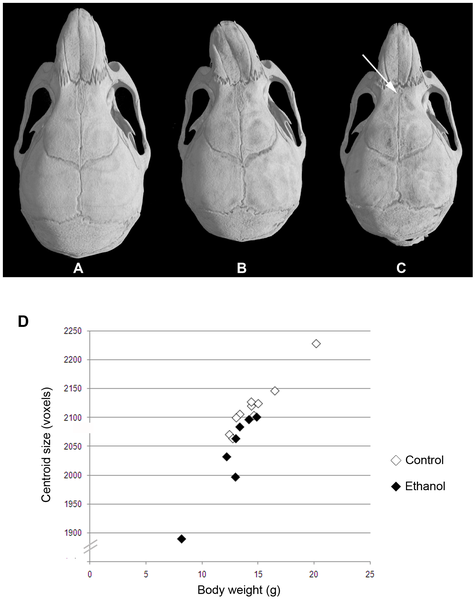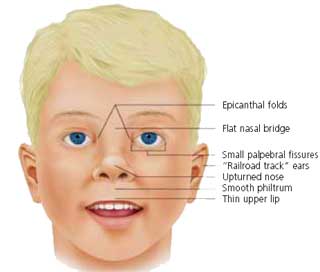Abnormal Development - Fetal Alcohol Syndrome
Introduction

This disorder was clinically described (USA) in humans about 30 years ago (1973), while historically alcohol's teratogenic effects were identified in the early 20th century in a mix with the prohibition cause of the period.
Consuming alcohol during pregnancy is the cause of Fetal Alcohol Syndrome (FAS), consisting of a variable degree of birth defects and mental retardation, initially identified by a reduced head size and distinctive facial features.
Similar effects without the obvious alterations to appearance, but with nervous system effects, are sometimes typified as Fetal Alcohol Effects (FAE). Alcohol is able to cross the placenta from maternal circulation through the placenta into fetal circulation.
Exposure of embryos in vitro to ethanol simulates premature differentiation of prechondrogenic mesenchyme of the facial primordia.[2] This result may explain some facial abnormalities associated with FAS, the mechanism of which is still unknown.
Alcohol intake is also one of several factor known to impact upon birthweight. In Australia (2005) 6.4% of all liveborn babies were of low birthweight (less than 2,500 grams).
Cell death (apoptosis) induced by alcohol has also been suggested as relevant to craniofacial abnormalities and neurological development. The neurological effects (FAS limits IQ to around 70) may be due to cell death in the embryonic neuroepithelium (the outer layer of the developing neural tube) at an early developmental stage. Some additional evidence suggests that alcohol could also directly damage DNA.
These developmental abnormalities are maternal in origin and are not genetic, though there are probably genetic elements involved with alcoholism (More? OMIM alcoholism).
This Syndrome is 100% preventable.
Some Recent Findings
- Magnetic resonance microscopy defines ethanol-induced brain abnormalities in prenatal mice[3] "This study demonstrates that exposure to ethanol occurring in mice at stages corresponding to the human fourth week postfertilization results in structural brain abnormalities that are readily identifiable at fetal stages of development."
- Maternal ethanol consumption alters the epigenotype and the phenotype of offspring in a mouse model.[4] "Our work raises the possibility of a role for epigenetics in the etiology of fetal alcohol spectrum disorders, and it provides a mouse model that will be a useful resource in the continued efforts to understand the consequences of gestational alcohol exposure at the molecular level."
- Number Processing in Children With Fetal Alcohol Syndrome[5] "The data suggest that, whereas control children rely primarily on the fronto-parietal network identified in previous studies to mediate number processing, children with FAS/PFAS recruit a broader range of brain regions to perform these relatively simple number processing tasks. Our results are consistent with structural neuroimaging findings indicating that the parietal lobe is relatively more affected by prenatal alcohol exposure and provide the first evidence for brain activation abnormalities during number processing in children with FAS/PFAS, effects that persist even after controlling statistically for group differences in total intracranial volume and IQ."
- Cardiac birth defects in mice and prevention with folate[6] "Pregnant mice on embryonic day 6.75 during gastrulation were exposed by an intraperitoneal injection to a binge-drinking dose of ethanol. Folic acid supplementation of mouse diet was tested for the prevention of ethanol-induced cardiac birth defects. RESULTS: Acute ethanol exposure induced myocardial wall changes and atrioventricular and semilunar valve defects, which was determined by echocardiography on embryonic day 15.5. A high folate diet prevented the ethanol-induced cardiac defects. Ethanol exposure in avian embryos suppressed 2 key Wnt-modulated genes that are involved in cardiac induction; folic acid rescued normal gene expression. CONCLUSION: Folic acid supplementation alone or with myoinositol prevented alcohol potentiation of Wnt/beta-catenin signaling that allowed normal gene activation and cardiogenesis."
- Proceedings of the 2008 annual meeting of the Fetal Alcohol Spectrum Disorders Study Group.[7]
Fetal Alcohol Spectrum Disorders
"Fetal Alcohol Spectrum Disorders (FASD) is an umbrella term describing the range of effects that can occur in an individual whose mother drank alcohol during pregnancy. These effects may include physical, mental, behavioral, and/or learning disabilities with possible lifelong implications. The term FASD is not intended for use as a clinical diagnosis." [8]
Fetal Alcohol Effect (FAE), Alcohol-related Birth Defect (ARBD), and Alcohol-Related Neurodevelopmental Disorder (ARND) are terms also used to describe a the spectrum of conditions related to prenatal alcohol exposure.
About Alcohol
The pure chemical, alcohol is generally available in alcoholic beverages at between 0.5 - 40% concentration. Metabolic rates for alcohol differ between men and women and is also dependent on body size. (More? [../msds/alcohol.htm MSDS datasheet for alcohol])
The neurological euphoria induced by alcohol has been associated with the rapid release of dopamine in limbic areas of the brain.
Not all FAS babies are from alcoholics, but they do represent a significant population more at risk. The genetics of alcoholism are multifactorial, with several candidate genes identified as associated with the disease. (More? OMIM - Alcoholism)
Alcohol Statistics
Statistical information is often difficult to isolate directly, as alcohol is often combined with other drugs (tobacco, illicit drugs, etc).
There is an interesting "American paradox" that Americans have a relatively low rate of per capita alcohol consumption, yet the USA has the highest incidence of FAS (20 times all other countries) in the world.
USA studies by the CDC have reported FAS prevalence rates from 0.2 to 1.5 cases per 1,000 births across various populations. Disadvantaged groups, Native Americans and Australians, and other minorities have been documented to have rates as high as three to five FAS affected children per 1,000 children.[8]
Other studies reflecting a variety of ascertainment methodologies have produced estimates ranging from 0.5 to 2.0 cases per 1,000 live births. Using the CDC FAS estimates, among the approximately 4 million infants born each year, an estimated 1,000 to 6,000 will be born with FAS. Studies of particularly vulnerable populations yield prevalence estimates that far exceed those of other common disabilities.
Binge Drinking
Tracking binge drinking among U.S. childbearing-age women.[9] "The estimated binge drinking prevalence among childbearing-age women 18-44 years (USA) for the years 2001, 2002, and 2003 was 11.9%, 12.4%, and 13.0%, respectively. The estimated number of childbearing-age women who engaged in binge drinking rose from 6.2 million in 2001 to 7.1 million in 2003, an increase of 0.9 million."
FAS Diagnosis
There are a range of postnatal features which are used diagnostically including facial appearance and digit effects.
In addition, there are under development a number of different techniques which may be useful in the future for prenatal diagnosis.
Pregnancy characteristics of women giving birth to children with fetal alcohol syndrome in Far North Queensland.[10] "There is the potential to identify prospectively women presenting for antenatal care who are heavy drinkers and risk FAS in their infants, using the self-reported information about alcohol intake already being collected by our service; such women may then be offered specific interventions to try to reduce alcohol consumption in pregnancy."
Facial Appearance of FAS
Some, or all, of the following facial features are associated with FAS. There has also been a recent study to develop an automated facial analysis technique.[11]
FAS facial features[1]
- Microcephaly - leads to small head circumference
- Palpebral fissure - short opening of eye
- Epicanthal folds - fold of skin at inside of corner of eye
- Midface - flat
- Nasal Bridge - low
- Philtrum - Indistinct, vertical grooves between nose and mouth
- Upper Lip - thin
- Micrognathia - small jaw
- Ears - curve at top part of outer ear is underdeveloped and folded over parallel to curve beneath. Gives the appearance of a "railroad track"
Mouse Model

|
| Variable midfacial dysmorphism and microcephaly in a/a offspring of mothers that consumed ethanol during gestation[4] |
FAS Digital Effects
In addition to the distinct facial effects, there may also be abnormalities associated with the digits, fingers or toes.
- Camptodactyly - permanent flexion contracture of a finger or toe
- Clinodactyly - permanent curving of the fifth finger (usually toward the other fingers) also seen for other fingers or toes
- Palmar crease - transverse flexion crease of the palm close to the fingers, described as "Hockey stick", widens like the end of a hockey stick and ends between the second and third fingers
Guidelines
2005 USA Guidelines
2005 USA Guidelines Fetal Alcohol Syndrome Prevention Team, Division of Birth Defects and Developmental Disabilities, National Center on Birth Defects and Developmental Disabilities[12]
Publication by national task force (USA)[13]
2005 Canadian Guidelines
Fetal alcohol spectrum disorder: Canadian guidelines for diagnosis[14] "The guidelines are based on widespread consultation of expert practitioners and partners in the field. The guidelines have been organized into 7 categories: screening and referral; the physical examination and differential diagnosis; the neurobehavioural assessment; and treatment and follow-up; maternal alcohol history in pregnancy; diagnostic criteria for fetal alcohol syndrome (FAS), partial FAS and alcohol-related neurodevelopmental disorder; and harmonization of Institute of Medicine and 4-Digit Diagnostic Code approaches. The diagnosis requires a comprehensive history and physical and neurobehavioural assessments; a multidisciplinary approach is necessary."
2009 Australia Draft Guidelines
26 August 2008 Draft Australian alcohol guidelines for low-risk drinking[15] "Following the initial consideration by the NHMRC Council, NHRMC is finalising the NHMRC Australian alcohol guidelines for low risk drinking, including the latest research. The Council is expected to consider them again in late 2008."
- Pregnancy characteristics of women giving birth to children with fetal alcohol syndrome in Far North Queensland. [16] "There is the potential to identify prospectively women presenting for antenatal care who are heavy drinkers and risk FAS in their infants, using the self-reported information about alcohol intake already being collected by our service; such women may then be offered specific interventions to try to reduce alcohol consumption in pregnancy."
Links: Draft Australian alcohol guidelines for low-risk drinking | National Alcohol Strategy Publications | National Alcohol Strategy 2001 to 2003-04 Occasional Paper
Finland
Fetal alcohol spectrum disorders in Finland: clinical delineation of 77 older children and adolescents.[17] "We have recently completed dysmorphology examination and parent/guardian interviews of the 77 children in the Finnish cohort. ...Although 11% were born prematurely, 70% demonstrated prenatal growth deficiency, and 45% were microcephalic. Other than growth deficits and the cardinal facial features, the most common major and minor anomalies noted were: camptodactyly (55%), "hockey stick" or other altered palmar creases (51%), refractive errors (40%), strabismus (38%), dental crowding (43%), nail hypoplasia (38%), GU anomalies (22%), and congenital heart defects (18%), "Railroad track" ears were not observed in this population."
Brain Development
New brain imaging techniques have allowed greater insight into the effects of alcohol on the brain. In FAS children this includes qualitative and quantitative studies of the postnatal brain including changes include anatomical displacements (corpus callosum) and changes in the neural layer (gray matter) density of the brain.
Abnormal cortical thickness and brain-behavior correlation patterns in individuals with heavy prenatal alcohol exposure.[18] "Significant cortical thickness excesses of up to 1.2 mm were observed in the FASD subjects in large areas of bilateral temporal, bilateral inferior parietal, and right frontal regions."
Teratogenic effects of alcohol: a decade of brain imaging.[19] "Results indicated displacements in the corpus callosum, increased gray matter densities in both hemispheres in the perisylvian regions, and altered gray matter asymmetry in portions of the temporal lobes in the brains of alcohol-exposed subjects."
Sensory Development
Prenatal alcohol exposure delays the development of the cortical barrel field in neonatal rats.[20] "...our model system to examine the effect of prenatal alcohol exposure (PAE) on early somatosensory cortical development. ....These findings suggest that PAE delays the development of the somatosensory cortex (SI); such delays may interfere with timing and formation of cortical circuits."
Bone Development
Binge alcohol exposure during all three trimesters alters bone strength and growth in fetal sheep.[21] "Maternal bones were not different among groups. The higher alcohol dose resulted in reduced fetal femoral bone strength, whereas the tibial bone strength was lower when compared with the normal control subjects. In contrast, the lower alcohol dose increased fetal femoral strength compared to the normal control subjects. The alcohol-exposed fetal bones also tended to exhibit reduced lengths."
References
- ↑ 1.0 1.1 <pubmed>16050451</pubmed>
- ↑ <pubmed>10235393</pubmed>
- ↑ <pubmed>19302087</pubmed>| Alcoholism: Clinical and Experimental Research
- ↑ 4.0 4.1 <pubmed>20084100</pubmed> | PLoS
- ↑ <pubmed>20528824</pubmed>
- ↑ <pubmed>20451895</pubmed>
- ↑ <pubmed>19560631</pubmed>
- ↑ 8.0 8.1 Bertrand J, Floyd RL, Weber MK, O'Connor M, Riley EP, Johnson KA, Cohen DE, National Task Force on FAS/FAE. Fetal Alcohol Syndrome: Guidelines for Referral and Diagnosis. Atlanta, GA: Centers for Disease Control and Prevention; 2004. PDF
- ↑ <pubmed>17150249</pubmed>
- ↑ <pubmed>18532953</pubmed>
- ↑ <pubmed>18713153</pubmed>
- ↑ <pubmed>16251866</pubmed>
- ↑ FAS Fetal Alcohol Syndrome: Guidelines for Referral and Diagnosis." Atlanta, GA: Centers for Disease Control and Prevention; 2004. Bertrand J, Floyd RL, Weber MK, O'Connor M, Riley EP, Johnson KA, Cohen DE, National Task Force on FAS/FAE.
- ↑ <pubmed>15738468</pubmed>
- ↑ NHMRC Website alcohol guidelines
- ↑ <pubmed>18532953</pubmed>
- ↑ <pubmed>16353236</pubmed>
- ↑ <pubmed>17443018</pubmed>
- ↑ <pubmed>15095470</pubmed>
- ↑ <pubmed>16506013</pubmed>
- ↑ <pubmed>16905445</pubmed>
Reviews
Reviews Fetal Alcohol Syndrome
- Riley EP, McGee CL. Fetal alcohol spectrum disorders: an overview with emphasis on changes in brain and behavior. Exp Biol Med (Maywood). 2005 Jun;230(6):357-65.
- Chudley AE, Conry J, Cook JL, Loock C, Rosales T, LeBlanc N [See Related Articles] Fetal alcohol spectrum disorder: Canadian guidelines for diagnosis. (Public Health Agency of Canada's National Advisory Committee on Fetal Alcohol Spectrum Disorder.) CMAJ. 2005 Mar 1;172(5 Suppl):S1-S21.
- Sulik KK. [See Related Articles] Genesis of alcohol-induced craniofacial dysmorphism. Exp Biol Med (Maywood). 2005 Jun;230(6):366-75. Review.
- Caley LM, Kramer C, Robinson LK. [See Related Articles] Fetal alcohol spectrum disorder. J Sch Nurs. 2005 Jun;21(3):139-46.
- Hoyme HE, May PA, Kalberg WO, Kodituwakku P, Gossage JP, Trujillo PM, Buckley DG, Miller JH, Aragon AS, Khaole N, Viljoen DL, Jones KL, Robinson LK. [See Related Articles] A practical clinical approach to diagnosis of fetal alcohol spectrum disorders: clarification of the 1996 institute of medicine criteria. Pediatrics. 2005 Jan;115(1):39-47.
- Patel VB, Why HJ, Richardson PJ, Preedy VR. [See Related Articles] Fetal alcohol syndrome: diagnosis, epidemiology, and developmental outcomes. J Paediatr Child Health. 2004 Jan-Feb;40(1-2):2-7.
- Bertrand J, Floyd RL, Weber MK, O'Connor M, Riley EP, Johnson KA, Cohen DE. National Task Force on FAS/FAE. Fetal Alcohol Syndrome: Guidelines for Referral and Diagnosis. Atlanta, GA: Centers for Disease Control and Prevention; 2004.
- Eustace LW, Kang DH, Coombs D. [See Related Articles] Fetal alcohol syndrome: a growing concern for health care professionals. J Obstet Gynecol Neonatal Nurs. 2003 Mar-Apr;32(2):215-21.
- May PA, Gossage JP. [See Related Articles] Estimating the prevalence of fetal alcohol syndrome. A summary. Alcohol Res Health. 2001;25(3):159-67.
Reviews Alcohol Tissue Damage
- Medina AE, Ramoa AS. [See Related Articles] Early alcohol exposure impairs ocular dominance plasticity throughout the critical period. Brain Res Dev Brain Res. 2005 Jun 9;157(1):107-11.
- Medina AE, Krahe TE, Coppola DM, Ramoa AS. [See Related Articles] Neonatal alcohol exposure induces long-lasting impairment of visual cortical plasticity in ferrets. J Neurosci. 2003 Nov 5;23(31):10002-12.
- Patel VB, Why HJ, Richardson PJ, Preedy VR. [See Related Articles] The effects of alcohol on the heart. Adverse Drug React Toxicol Rev. 1997 Mar;16(1):15-43
- Apte MV, Norton ID, Wilson JS. [See Related Articles] Ethanol induced acinar cell injury. Alcohol Alcohol Suppl. 1994;2:365-8.
Reviews Fatty Acid Ethyl Esters
- Chan D, Caprara D, Blanchette P, Klein J, Koren G. [See Related Articles] Recent developments in meconium and hair testing methods for the confirmation of gestational exposures to alcohol and tobacco smoke. Clin Biochem. 2004 Jun;37(6):429-38.
- Swift R. [See Related Articles] Direct measurement of alcohol and its metabolites. Addiction. 2003 Dec;98 Suppl 2:73-80.
- Soderberg BL, Salem RO, Best CA, Cluette-Brown JE, Laposata M. [See Related Articles] Fatty acid ethyl esters. Ethanol metabolites that reflect ethanol intake. Am J Clin Pathol. 2003 Jun;119 Suppl:S94-9.
- Best CA, Laposata M. [See Related Articles] Fatty acid ethyl esters: toxic non-oxidative metabolites of ethanol and markers of ethanol intake. Front Biosci. 2003 Jan 1;8:e202-17.
- Musshoff F. [See Related Articles] Chromatographic methods for the determination of markers of chronic and acute alcohol consumption. J Chromatogr B Analyt Technol Biomed Life Sci. 2002 Dec 5;781(1-2):457-80.
- Sirtori CR, Galli C. [See Related Articles] N-3 fatty acids and diabetes. Biomed Pharmacother. 2002 Oct;56(8):397-406.
- Laposata M, Hasaba A, Best CA, Yoerger DM, McQuillan BM, Salem RO, Refaai MA, Soderberg BL. [See Related Articles] Fatty acid ethyl esters: recent observations. Prostaglandins Leukot Essent Fatty Acids. 2002 Aug-Sep;67(2-3):193-6.
- Koren G, Chan D, Klein J, Karaskov T. [See Related Articles] Estimation of fetal exposure to drugs of abuse, environmental tobacco smoke, and ethanol. Ther Drug Monit. 2002 Feb;24(1):23-5.
- Agarwal DP. [See Related Articles] Genetic polymorphisms of alcohol metabolizing enzymes. Pathol Biol (Paris). 2001 Nov;49(9):703-9.
- Soderberg BL, Laposata M. [See Related Articles] Fatty acid ethyl esters: markers of ethanol intake. Am Clin Lab. 2001 Sep;20(8):18-20.
- Laposata M. [See Related Articles] Fatty acid ethyl esters: current facts and speculations. Prostaglandins Leukot Essent Fatty Acids. 1999 May-Jun;60(5-6):313-5.
- Beckemeier ME, Bora PS. [See Related Articles] Fatty acid ethyl esters: potentially toxic products of myocardial ethanol metabolism. J Mol Cell Cardiol. 1998 Nov;30(11):2487-94.
- Laposata M. [See Related Articles] Fatty acid ethyl esters: ethanol metabolites which mediate ethanol-induced organ damage and serve as markers of ethanol intake. Prog Lipid Res. 1998 Nov;37(5):307-16.
- De Jersey J, Treloar T. [See Related Articles] Biosynthesis and possible pathological significance of fatty acid ethyl esters. Alcohol Alcohol Suppl. 1994;2:171-6.
- Bora PS, Lange LG. [See Related Articles] Molecular mechanism of ethanol metabolism by human brain to fatty acid ethyl esters. Alcohol Clin Exp Res. 1993 Feb;17(1):28-30.
Articles
- Fang S, McLaughlin J, Fang J, Huang J, Autti-Rämö I, Fagerlund A, Jacobson SW, Robinson LK, Hoyme HE, Mattson SN, Riley E, Zhou F, Ward R, Moore ES, Foroud T; Collaborative Initiative on Fetal Alcohol Spectrum Disorders. Automated diagnosis of fetal alcohol syndrome using 3D facial image analysis. Orthod Craniofac Res. 2008 Aug;11(3):162-71.
- Coyne KL, de Costa CM, Heazlewood RJ, Newman HC. Pregnancy characteristics of women giving birth to children with fetal alcohol syndrome in Far North Queensland. Aust N Z J Obstet Gynaecol. 2008 Jun;48(3):240-7.
- Jacobson SW, Stanton ME, Molteno CD, Burden MJ, Fuller DS, Hoyme HE, Robinson LK, Khaole N, Jacobson JL. Impaired eyeblink conditioning in children with fetal alcohol syndrome. Alcohol Clin Exp Res. 2008 Feb;32(2):365-72.
- Rothstein J, Heazlewood R, Fraser M; Paediatric Outreach Service. Health of Aboriginal and Torres Strait Islander children in remote Far North Queensland: findings of the Paediatric Outreach Service. Med J Aust. 2007 May 21;186(10):519-21.
- Stoller KP. [See Related Articles] Quantification of Neurocognitive Changes Before, During, and After Hyperbaric Oxygen Therapy in a Case of Fetal Alcohol Syndrome. Pediatrics. 2005 Sep 15
- Endres M, Toso L, Roberson R, Park J, Abebe D, Poggi S, Spong CY. [See Related Articles] Prevention of alcohol-induced developmental delays and learning abnormalities in a model of fetal alcohol syndrome. Am J Obstet Gynecol. 2005 Sep;193(3 Pt 2):1028-34.
- Hoyme HE, May PA, Kalberg WO, Kodituwakku P, Gossage JP, Trujillo PM, Buckley DG, Miller JH, Aragon AS, Khaole N, Viljoen DL, Jones KL, Robinson LK. A practical clinical approach to diagnosis of fetal alcohol spectrum disorders: clarification of the 1996 institute of medicine criteria. Pediatrics. 2005 Jan;115(1):39-47.
Search Pubmed
June 2010 "fetal alcohol syndrome" All (3475) Review (611) Free Full Text (396) "fetal alcohol spectrum disorders" All (306) Review (65) Free Full Text (84)
Search Pubmed: fetal alcohol syndrome | fetal alcohol effects | fetal alcohol spectrum disorders
Books on Fetal Alcohol Syndrome
A selection of recent general public information books on FAS and children with FAS, available from various internet commercial suppliers (search using the book title). Please note that this listing does not reflect an endorsement of the book or its content and is provided for educational purposes only.
- The Challenge of Fetal Alcohol Syndrome, by Ann Streissguth (editor) and Jonathan Kanter (editor)
- Recognizing and Managing Children With Fetal Alcohol Syndrome-Fetal Alcohol Effects, by Brenda McCreight
- Fetal Alcohol Syndrome, Fetal Alcohol Effects: Strategies for Professionals, by Diane Malbin
- Fetal Alcohol Syndrome: A Guide for Families and Communities, by Ann Pytkowicz Streissguth
- The Best I Can Be: Living with Fetal Alcohol Syndrome-Effects, by Liz Kulp and Jodee Kulp
- The Broken Cord, by Michael Dorris
- Our FAScinating Journey: Keys to Brain Potential Along the Path of Prental Brain Injury, by Jodee Kulp
- Fantastic Antone Grows Up: Adolescents and Adults With Fetal Alcohol Syndrome, by Judith Kleinfeld (editor), Barbara Morse (editor) and Siobhan Wescott (editor)
Internet supplier link: Amazon
External Links
- Medline Plus Fetal Alcohol Syndrome
- Australia
- The Medical Journal of Australia Health of Aboriginal and Torres Strait Islander children in remote Far North Queensland: findings of the Paediatric Outreach Service (Australia)
- Fetal Alcohol Syndrome: National Workshop, 2002 Report (Australia) (PDF document)
- Telethon Institute for Child Health Research - FAS (Australia)
- National Organisation for Foetal Alcohol Syndrome and Related Disorders (Australia)
- USA
- AMERICAN ACADEMY OF PEDIATRICS Policy Statement Fetal Alcohol Syndrome and Fetal Alcohol Effects (RE9310) Pediatrics Volume 91, Number 5 May, 1993, p1004-1006
- National Organization on FAS (USA)
- National Institute on Alcohol Abuse and Alcoholism (NIAAA, USA) Alcohol-Related Birth Defects,The Past, Present and Future
- Research Monographs on Drug Exposed Women and their Children. (NIDA, USA)
- American Academy of Family Physicians Fetal Alcohol Spectrum Disorders Article (2005)
- Addiction Resources, Information, Utilization & Mission (ARIUM, USA)
- UK
Glossary Links
- Glossary: A | B | C | D | E | F | G | H | I | J | K | L | M | N | O | P | Q | R | S | T | U | V | W | X | Y | Z | Numbers | Symbols | Term Link
Cite this page: Hill, M.A. (2024, May 21) Embryology Abnormal Development - Fetal Alcohol Syndrome. Retrieved from https://embryology.med.unsw.edu.au/embryology/index.php/Abnormal_Development_-_Fetal_Alcohol_Syndrome
- © Dr Mark Hill 2024, UNSW Embryology ISBN: 978 0 7334 2609 4 - UNSW CRICOS Provider Code No. 00098G



